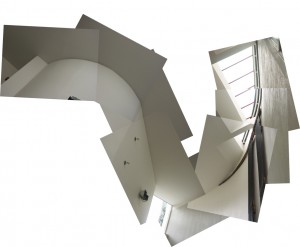 This Friday is the Centre for Building Research (VUW) symposium on 1980’s architecture. Robert Venturi is the designated Godfather of Po-Mo architecture because the publication of ‘Learning From Las Vegas’ (2nd ed. 1977). But I prefer his earlier treatise, Complexity and Contradiction, where Venturi cites Paul Rudolf’s critique of Mies:
This Friday is the Centre for Building Research (VUW) symposium on 1980’s architecture. Robert Venturi is the designated Godfather of Po-Mo architecture because the publication of ‘Learning From Las Vegas’ (2nd ed. 1977). But I prefer his earlier treatise, Complexity and Contradiction, where Venturi cites Paul Rudolf’s critique of Mies:
All problems can never be solved, indeed it is a characteristic of the twentieth century that architects are highly selective in determining which problems they want to solve. Mies, for instance, makes wonderful buildings only because he ignores many aspects of a building. If he solved more problems, his buildings would be far less potent.
– and from which emerges ‘less is a bore’. Post-Modernism Architecture had a fairly dreadful habit of making complex buildings that not only failed to address the complexities of the programme, but made new and even bigger problems.
But anyway, the quest is on to name the finest Po-Mo architecture in New Zealand, and though the temptation maybe to just aim for the tackiest pile of plastered polystyrene you can think of, I think Post-Modernism was the saving grace of architecture. And thus, speaking seriously (no matter how much Po-Mo likes to to ridicule seriousness!) I nominate Manning/Mitchell Architects School of Music Building in Auckland, New Zealand’s finest piece of Po-Mo.
Post Modernism is marvelous!
Comments
15 responses to “Post Modernism is marvelous!”
-
Didn’t Venturi explicitly reject and distance himself from the p-m label? Not that it really matters.
And I think there is a whole area of late Modernism that could have gone somewhere meaningful (Team 10, and especially those associated with the Dutch Forum, etc) – Po-Mo was the saving grace of nothing at all, and today’s retro-modernist-nothingism is simply a continuation of that, just in a slightly more insipid form…
-
That’s a tough proposition – nominating a good po-mo building, as both po-mo, and good, are such slippery variables. I’d, with some trepidation, put forward Athfield’s house as a possible contender, as it begins to consider the issues of habitation that Modernism ignored (and which were also neglected in the subsequent fashion for thinly applied signs and other games for architects)…
-
damn – I’ve been having a brain-block and can only think of Athfield ones too – Moore Wilsons? and is the Wellington Public Library securely a PoMo-ian?
-
Moore Wilson’s is more of a ‘copy’ than a ‘reference’ – but does that make it any less good or any less po-mo??
How ’bout WAM’s New Delhi Chancery, if you want to go down the droll po-mo classical reference thing – it might be a good example of its type, but as with all examples of its type, you can’t call it outright good.
But I’d also make a case for more recent buildings, such as the Meridian Building for example – the references may be Modern rather than Classical, but is it really any different for that…?
-
Jencks’ definitions of Post Modernism were quite clear, from memory, involving historical references and ‘signs’ and ironic role playing (where a building ‘speaks’ and makes jokes). Hence the preponderance of PoMo buildings with classically inspired pediments, such as the AT&T in NY, the Compudigm House in Wellington (WaM), – in fact, every single WaM building from the 80s in Wellington and Christchurch could / should / would be classified as a Post Modern building. They had a real thing going in the PoMo department then.
Athfield’s buildings were not only PoMo but also kitsch at times – arguably still are kitsch in many ways, even today – which is not necessarily a bad thing.
Can anything be called PoMo today? The phrase surely sits squarely in the 80s where it belongs. If someone does a modern house today, like they built in the 50s, does that make it a Modern house? or just a modern house in the style of Modernism? Mind you, no one deliberately sticks pediments on buildings nowadays, so surely no building would be called PoMo today.
Thomas mentions the Meridian building – not by WaM (well, the inside fitout is), but by Studio Pacific – and I fail to see how it could be called PoMo – perhaps it could be termed retro-modernist-nothingism, but it is certainly not insipid. You could say it is Post-Post-Modern, although that’s a bit of a mouthful, and as my mother used to say, “Don’t talk with your mouth full.”
Not sure if the phrase has been used before (or if Jencks et al have ‘officially’ decreed a new category) but Neo-Modernism would seem to work there. Meaning of course, a modern version of Modernism, knowing the issues of both modernism and post-modernism, and moving on from there to a new state.
Much as m-d is doing, I’d imagine…
-
Well, following that, I don’t see how Mitchell’s School of Music could be labelled PoMo. Sure, it is a very fine building – too fine for Auckland, really, but it doesn’t actively create any classically inspired shapes or forms, just uses the two old house entrances in a clever way. It seems more a modern version of Miami style streamlined Deco….
-
I wasn’t referring to the Meridian as a WAM creation (despite the ambiguous writing…), but apologies to Studio Pacific anyway…
Jencks’ is a poor definition to rely on – it doesn’t cover much of what is legitimately Po-Mo. And even as far as the ironic referencing is concerned, Po-Mo was not restricted solely to Classical allusions. The early work championed by Ernesto Rogers (probably who I would put forward as the Godfather), for example, referred to the early 20th century Italian Neoliberty movement. Certainly a lot of Venturi’s work wouldn’t fit into Jenks’definition…
NeoModernism has been used before, but usually refers to an adoption of the Modernist aesthetic (rather than ethic) – to me this is little different to Po-Mo, it just has a different source book – although admittedly it does have less overt irony in its favour…
-
Actually, come to think of it, the building on the cover of “The Elegant Shed” draws specifically (and ironically) upon Modernist aesthetics, and is generally upheld, not the least by its author, as a work of high Po-Mo. Have we moved beyond this?
-
High Po-Mo ? Never really heard of that…. but I can understand where you are coming from, certainly in relation to Low quality Po-Mo….
It’s interesting – the so-called ‘masters’ of ‘High Tech’ (Rogers, Foster etc) really hate the label High Tech and never call their work that. Certainly their later work is more Modern and less Tech.
Is it the Gibbs House on the Cover of the Elegant Shed? Personally, yes, I would say Mitchell’s Gibbs House has moved beyond Pomo and is no longer “Po-Mo”.
While everything beyond / past the Modern is, by nature, post Modern, it doesn’t mean that everything post Modern is actually Post Modern….
-
OK, I confess, you’ve got me. What on earth is that top picture a photo of? (or, series of photos).
Is that the inside of a building I’m meant to recognise? Cos i don’t.
-
The montage is the curved interior of the School of Music Building – no, no one was really supposed to recognise it. I was just please with myself for having made it. The bottom is of Dave Mitchell rowing a boat in ‘The Elegant Shed’.
In 1984 Hal Foster argued that there were two kinds of Po-Mo: Neo-Conservative (with polystyrene Corinthian columns attached – Venturi, Stern, Jencks et al – whether they like being together or not), and Post-structuralist (undertaking a critique of the very possibility of representation). Mitchell inferred at times the design of the school was based on a piano, a violin, an ear, some gum. It is & isn’t these things, and whether you can ‘see’ the gum while in the building is the critical point – i guess. -
sorry i think i meant Graves, not Stern
-
PoMo alive and well, sans Classical reference…
http://www.archdaily.com/16598/hemeroscopium-house-ensamble-studio/ -
That (Hemeroscopium) wouldn’t be for a owner of a concrete precasting products plant would it? Looks like he / she might have got some products left over that were used….
-
yes but which one is the best – I mean finest – bit of Po Mo? perhaps one that doesn’t leak?


Leave a Reply